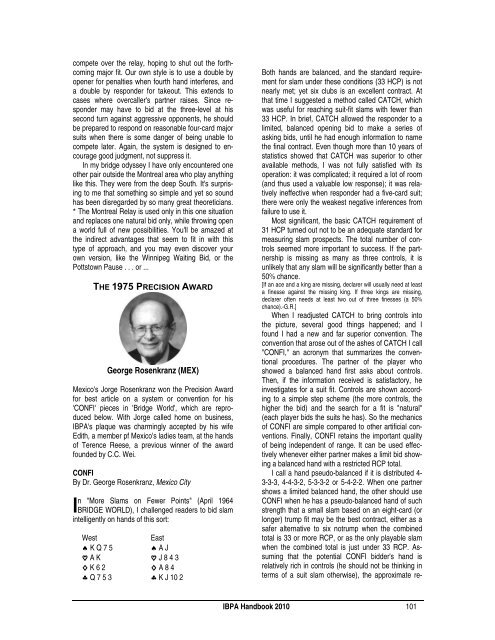Handbook - International Bridge Press Association
Handbook - International Bridge Press Association
Handbook - International Bridge Press Association
You also want an ePaper? Increase the reach of your titles
YUMPU automatically turns print PDFs into web optimized ePapers that Google loves.
compete over the relay, hoping to shut out the forthcoming<br />
major fit. Our own style is to use a double by<br />
opener for penalties when fourth hand interferes, and<br />
a double by responder for takeout. This extends to<br />
cases where overcaller's partner raises. Since responder<br />
may have to bid at the three-level at his<br />
second turn against aggressive opponents, he should<br />
be prepared to respond on reasonable four-card major<br />
suits when there is some danger of being unable to<br />
compete later. Again, the system is designed to encourage<br />
good judgment, not suppress it.<br />
In my bridge odyssey I have only encountered one<br />
other pair outside the Montreal area who play anything<br />
like this. They were from the deep South. It's surprising<br />
to me that something so simple and yet so sound<br />
has been disregarded by so many great theoreticians.<br />
* The Montreal Relay is used only in this one situation<br />
and replaces one natural bid only, while throwing open<br />
a world full of new possibilities. You'll be amazed at<br />
the indirect advantages that seem to fit in with this<br />
type of approach, and you may even discover your<br />
own version, like the Winnipeg Waiting Bid, or the<br />
Pottstown Pause . . . or ...<br />
THE 1975 PRECISION AWARD<br />
George Rosenkranz (MEX)<br />
Mexico's Jorge Rosenkranz won the Precision Award<br />
for best article on a system or convention for his<br />
'CONFI' pieces in '<strong>Bridge</strong> World', which are reproduced<br />
below. With Jorge called home on business,<br />
IBPA's plaque was charmingly accepted by his wife<br />
Edith, a member pf Mexico's ladies team, at the hands<br />
of Terence Reese, a previous winner of the award<br />
founded by C.C. Wei.<br />
CONFI<br />
By Dr. George Rosenkranz, Mexico City<br />
I<br />
n "More Slams on Fewer Points" (April 1964<br />
BRIDGE WORLD), I challenged readers to bid slam<br />
intelligently on hands of this sort:<br />
West East<br />
♠ K Q 7 5 ♠ A J<br />
A K J 8 4 3<br />
K 6 2 A 8 4<br />
♣ Q 7 5 3 ♣ K J 10 2<br />
Both hands are balanced, and the standard requirement<br />
for slam under these conditions (33 HCP) is not<br />
nearly met; yet six clubs is an excellent contract. At<br />
that time I suggested a method called CATCH, which<br />
was useful for reaching suit-fit slams with fewer than<br />
33 HCP. In brief, CATCH allowed the responder to a<br />
limited, balanced opening bid to make a series of<br />
asking bids, until he had enough information to name<br />
the final contract. Even though more than 10 years of<br />
statistics showed that CATCH was superior to other<br />
available methods, I was not fully satisfied with its<br />
operation: it was complicated; it required a lot of room<br />
(and thus used a valuable low response); it was relatively<br />
ineffective when responder had a five-card suit;<br />
there were only the weakest negative inferences from<br />
failure to use it.<br />
Most significant, the basic CATCH requirement of<br />
31 HCP turned out not to be an adequate standard for<br />
measuring slam prospects. The total number of controls<br />
seemed more important to success. If the partnership<br />
is missing as many as three controls, it is<br />
unlikely that any slam will be significantly better than a<br />
50% chance.<br />
[If an ace and a king are missing, declarer will usually need at least<br />
a finesse against the missing king. If three kings are missing,<br />
declarer often needs at least two out of three finesses (a 50%<br />
chance).-G.R.]<br />
When I readjusted CATCH to bring controls into<br />
the picture, several good things happened; and I<br />
found I had a new and far superior convention. The<br />
convention that arose out of the ashes of CATCH I call<br />
"CONFI," an acronym that summarizes the conventional<br />
procedures. The partner of the player who<br />
showed a balanced hand first asks about controls.<br />
Then, if the information received is satisfactory, he<br />
investigates for a suit fit. Controls are shown according<br />
to a simple step scheme (the more controls, the<br />
higher the bid) and the search for a fit is "natural"<br />
(each player bids the suits he has). So the mechanics<br />
of CONFI are simple compared to other artificial conventions.<br />
Finally, CONFI retains the important quality<br />
of being independent of range. It can be used effectively<br />
whenever either partner makes a limit bid showing<br />
a balanced hand with a restricted RCP total.<br />
I call a hand pseudo-balanced if it is distributed 4-<br />
3-3-3, 4-4-3-2, 5-3-3-2 or 5-4-2-2. When one partner<br />
shows a limited balanced hand, the other should use<br />
CONFI when he has a pseudo-balanced hand of such<br />
strength that a small slam based on an eight-card (or<br />
longer) trump fit may be the best contract, either as a<br />
safer alternative to six notrump when the combined<br />
total is 33 or more RCP, or as the only playable slam<br />
when the combined total is just under 33 RCP. Assuming<br />
that the potential CONFI bidder's hand is<br />
relatively rich in controls (he should not be thinking in<br />
terms of a suit slam otherwise), the approximate re-<br />
IBPA <strong>Handbook</strong> 2010 101


